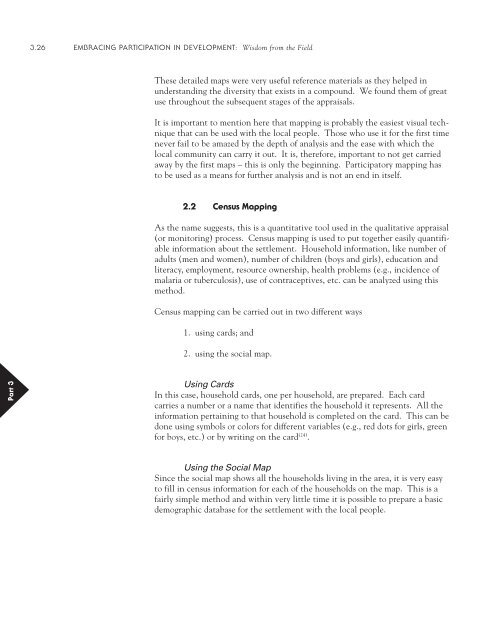PRA-Manual Embracing Participitation tools-only.pdf - PACA
PRA-Manual Embracing Participitation tools-only.pdf - PACA
PRA-Manual Embracing Participitation tools-only.pdf - PACA
Create successful ePaper yourself
Turn your PDF publications into a flip-book with our unique Google optimized e-Paper software.
3.26 EMBRACING PARTICIPATION IN DEVELOPMENT: Wisdom from the Field<br />
These detailed maps were very useful reference materials as they helped in<br />
understanding the diversity that exists in a compound. We found them of great<br />
use throughout the subsequent stages of the appraisals.<br />
It is important to mention here that mapping is probably the easiest visual technique<br />
that can be used with the local people. Those who use it for the first time<br />
never fail to be amazed by the depth of analysis and the ease with which the<br />
local community can carry it out. It is, therefore, important to not get carried<br />
away by the first maps – this is <strong>only</strong> the beginning. Participatory mapping has<br />
to be used as a means for further analysis and is not an end in itself.<br />
2.2 Census Mapping<br />
As the name suggests, this is a quantitative tool used in the qualitative appraisal<br />
(or monitoring) process. Census mapping is used to put together easily quantifiable<br />
information about the settlement. Household information, like number of<br />
adults (men and women), number of children (boys and girls), education and<br />
literacy, employment, resource ownership, health problems (e.g., incidence of<br />
malaria or tuberculosis), use of contraceptives, etc. can be analyzed using this<br />
method.<br />
Census mapping can be carried out in two different ways<br />
1. using cards; and<br />
2. using the social map.<br />
Part 3<br />
Using Cards<br />
In this case, household cards, one per household, are prepared. Each card<br />
carries a number or a name that identifies the household it represents. All the<br />
information pertaining to that household is completed on the card. This can be<br />
done using symbols or colors for different variables (e.g., red dots for girls, green<br />
for boys, etc.) or by writing on the card (24) .<br />
Using the Social Map<br />
Since the social map shows all the households living in the area, it is very easy<br />
to fill in census information for each of the households on the map. This is a<br />
fairly simple method and within very little time it is possible to prepare a basic<br />
demographic database for the settlement with the local people.














